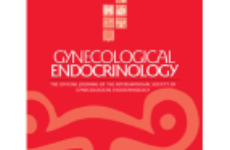 Aim of the study
Aim of the study
was an evaluation of the effects, exerted by obtained haemostasis on ovarian reserve, depending on haemostasis technique, applied after laparoscopic enucleation of endometrial cysts.
Material and methods
Sixty-six female patients, at the age of 20−35 years, were included into the study. The diameters of the cystic lesions were within 40−70 mm. The patients were randomly assigned to two study groups. Group 1 involved patients after laparoscopic enucleation of ovarian cysts, in whom haemostasis was achieved by ovary suturing, while Group 2 included patients with haemostasis achieved by bipolar coagulation technique. Cyst enucleation was performed in all the patients by the stripping method. Ovarian reserve markers: AFC (antral follicle count), AMH (anti-Müllerian hormone), and inhibin B were assayed before and three months after the surgery.
Results
The preoperative values of AMH, AFC, and inhibin B were similar in both studied groups. After a three-month follow up, the post-operative levels of AMH and inhibin B were significantly lower (p < 0.05), while the numbers of antral follicles did not reveal any statistical differences (p > 0.05). While comparing endometrial and dermoid cysts in the sutured group of patients, the difference, regarding AMH, was statistically significant (2.13 vs. 4.69, p = 0.03). In the group of patients after bipolar coagulation, the corresponding differences did not attain statistical significance (2.21 vs. 6.51, p = 0.86)
Conclusions
Comparing pre- and post-operative levels of AMH and inhibin B, regardless of the applied haemostasis technique, a statistically significant reduction of the ovarian reserve was observed in either group. Comparing both haemostasis techniques, no method was demonstrated that would have decreased less the levels of AMH, AFC, or inhibin B.
Dariusz Owczarek, Andrzej Malinowski, Miłosz Wilczyński
Menopause Rev 2018; 17(1): 22−27
DOI: doi. org/10.5114/pm.2018.74 899
















 Информация, представленная на сайте, предназначена для специалистов здравоохранения и не должна использоваться для самостоятельной диагностики и лечения.
Информация, представленная на сайте, предназначена для специалистов здравоохранения и не должна использоваться для самостоятельной диагностики и лечения.